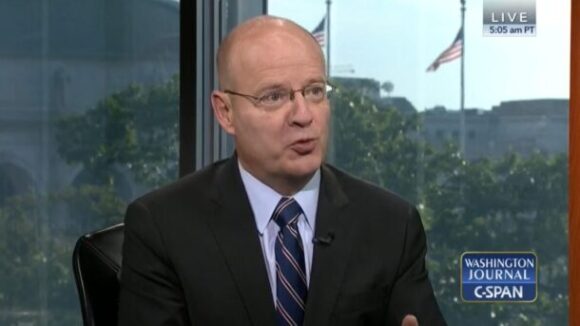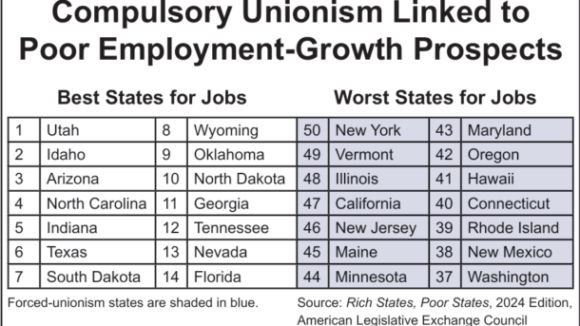Will Team Biden Weaponize Workers’ Pensions?
Big Labor abuse of worker pension and benefit funds as a means of advancing union bosses’ self-aggrandizing policy objectives is a familiar phenomenon.
By Professor Richard Vedder (Condensed from the original 10-page Article appearing in the Cato Journal, Vol. 30, No. 1 (Winter 2010). Produced by the Cato Institute. Richard Vedder is Edwin and Ruth Kennedy Distinguished Professor of Economics at Ohio University.)
The most essential ingredient embodied in the liberty championed by the classical liberal writers of the Enlightenment and beyond is individual choice and right of expression—the right of persons to say what they think, decide for themselves what groups that want to join, what religion that want to profess, what person they want to marry, what goods they want to buy or sell, and what persons they want to represent them where necessity requires collective decision making.
One important economic dimension of individual liberty is the right to sell one’s labor services without attenuation—that is, without limits on the terms of the agreement (e.g., wage rates and hours of work), or who will represent the worker in reaching those terms.
The eroding of employment liberty in the United States had begun before the 1930s … legislation in the early 1930s such as the Davis-Bacon Act and, to a lesser degree, the Norris-LaGuardia Act began to chip away at bargaining freedom, but it was the National Labor Relations Act of 1935 (Wagner Act) that dramatically revolutionized employment contracts, severely restricting the freedom of workers and employers to reach individual bargaining arrangements.
Required union representation elections allowed for a small majority of workers to force other workers to join a union or lose their job. Under the closed shop arrangement permissible under the Wagner Act, unions controlled who was hired, since union membership was mandatory for employment.
Congress enacted the Taft-Hartley Act, and Congress overrode a veto of the legislation by pro-union President Harry Truman. Fortunately, there was one important provision (section 14b) in Taft-Hartley that works to significantly lower the infringements on liberty and adverse economic effects of the law—namely, state governments can pass right-to-work laws that outlaw union shop collective bargaining agreements, permitting individual workers to decide whether they want to join a labor union or not.
At present 22 states have adopted right-to-work laws. None of the 14 states in the Northeast or East Central parts of the country (industrial Midwest) have these laws, as unions have been successful in thwarting their passage. Outside of that area, however, a solid majority of Americans (60 percent) now live in right-to-work states.
The Impact of Right-to-Work Laws on Migration Indeed, an important untold story is the rapid growth of population living in right-to-work states relative to states refusing to grant workers the right to reject unionization. In 1970, 28.5 percent of Americans lived in right-to-work states; by 2008, the proportion had risen to nearly 40 percent (to over 121 million).
Undoubtedly, the most important reason for the increase in the percentage of U.S. population living in right-to-work states has been because there has been a huge migration of persons from the nonright- to-work states to those allowing greater personal liberty with respect to employment.
Unions cannot erect Berlin-type walls to prevent people fleeing states where employment contracts are constrained by law. Consequently, internal in-migration into the right-to- work states has been astonishing.
For example, U.S. Census Bureau population estimate data show that more than 4.7 million Americans moved from the non-right-to-work states to right-to-work states from April 1, 2000, to July 1, 2008—on average more than one person every single minute of that eight years (U.S. Bureau of the Census 2009).
Without exception, in all the estimations, a statistically significant positive relationship (usually at the 1 percent level) was observed between the presence of right-to-work laws and net migration. Right-to-work laws potentially have powerful positive economic effects. [Vedder’s analysis shows annual income averages increase more rapidly in Right to Work states.]
Moreover, if the current trends in labor markets continue, I would suspect the longer-term prognosis is for right-to-work to expand, not contract, although the magnitude and timing of this move is very difficult to predict.
The benefits of eliminating right-to-work are much smaller, but are concentrated among a vastly smaller group of labor union leaders. …so these potential beneficiaries of right-to-work elimination are willing to spend large sums of money [forced union dues] on lobbying and electing friendly politicians.
Americans generally prefer freedom to coercion, high incomes to low ones, and individual decision making to collective resolution of issues. For these reasons, they generally do not like laws that constrain their labor market behavior and force them to join collectives of other workers to negotiate their wages and working conditions.
The right-to-work provisions of the Taft-Hartley Act of 1947 have created sort of a natural experiment, providing an opportunity to observe behavior in two types of environments: one where workers are not compelled to join labor unions and a second where they can be compelled to join as a condition of employment.
The evidence is absolutely clear: Americans prefer the right-to-work environment to the alternative. The proportion of Americans living in right-to-work states has risen noticeably over the years, and only a small part of that is driven by new states adopting such laws. People move in extraordinary numbers to right-to-work states from states where union pressure has prevented the adoption of such laws.
Moreover, the greater flexibility for workers and employers offered where right-to-work exists has contributed to higher rates of economic growth rates in the right-to-work environment. Although the United States seems to have been in roughly a stable political equilibrium regarding these laws in recent decades … a threshold point should be passed where the political equilibrium should tip toward making right-to-work laws universal for the entire American population.

Big Labor abuse of worker pension and benefit funds as a means of advancing union bosses’ self-aggrandizing policy objectives is a familiar phenomenon.

What impact does handing a union monopoly power to deal with your employer on matters concerning your pay, benefits, and work rules have on your pay?

Wherever Big Labor wields the power to collect forced union dues, union bosses funnel a large share of the confiscated money into efforts to elect and reelect business-bashing politicians. Employment growth tends to lag as a consequence.